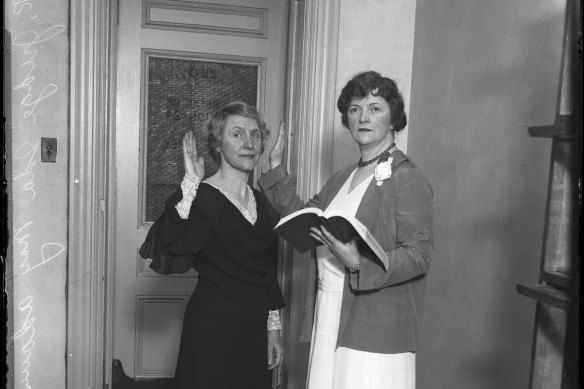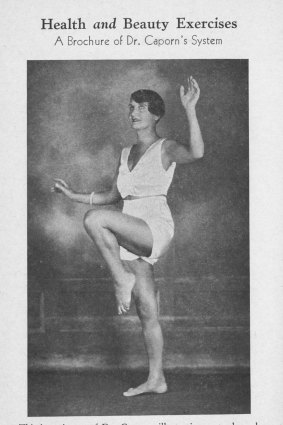
Some of Rees’ subjects had fortune smile upon them from the start. May Lahey, who eventually became a judge, had an uncle already living in the US, and he was allegedly so impressed by Lahey’s ability to hold her own in an argument at the dinner table that he offered to pay for her tuition at USC Law School, leading her to move abroad in 1910.
Not long after Rose Cumming landed in the US in 1916, she managed to have lunch with Vanity Fair magazine editor Frank Crowninshield. When she told him, “I’m perfectly useless. I don’t know how to do anything”, he suggested that she become a decorator, to which she responded, “Perhaps … but first tell me what it is?”

Judge May Lahey (right) administering the oath of office to judge Ida May Adams in Los Angeles, 1931.Credit: University of California, Los Angeles
It proved a prescient choice: Cumming would become one of the most iconic interior decorators, counting actresses Marlene Dietrich, Norma Shearer and Gloria Swanson as clients.
Others had to overcome more significant struggles. Dorothy Cottrell was wheelchair-bound since contracting polio as a child, and lived on a sheep station in remote Queensland. But when the aspiring writer sent her manuscript to Ladies’ Home Journal magazine in the US, staff there promptly wired her a message offering to pay $US5000 for its publication, and she was California-bound a year later in 1928.

Alice Caporn copped flak at home for dismissing cow’s milk for children.Credit: Radiant Health Publishers, Boston, USA.
But all the women were determined to make their mark on the world, exhibiting a tenacity, intelligence and talent that would likely have made them stand out anywhere. Persia Campbell, from Nerrigundah in NSW, became an economist who won scholarships and fellowships abroad, and eventually advised president John F. Kennedy on consumer economics.
Many were ahead of their time, such as Alice Caporn, a self-made health guru who received terrible backlash in Australia in 1939 when she pronounced cow’s milk as being unfavourable for people, and championed nut milk for children.
Time and again, it is clear that most of these women were constrained in their native country; when painter and art educator Mary Cecil Allen tried to display modern, abstract art to a Melbourne crowd after her time in New York, she was greeted with “eviscerating” reviews, while her former teacher crossed the road when he saw her, so horrified by the style of art she embraced.
Not all the subjects managed to remain in the US, but those who did were able to shed some of the expectations that had been placed upon them at home, especially when it came to their outward expressions of self. Later in life, Rose Cumming was prone to dying her hair blue or lavender and wearing such wayward outfits that she was once denied access to a Manhattan building by the doorman, who presumed she was homeless. Mary Cecil Allen, an artist, was sometimes known simply as Cecil Allen, and favoured an androgynous appearance, with cropped hairdo and pants.
As a collection of individual stories, Travelling to Tomorrow is a rollicking, bouncing read, even if it occasionally crams the pages with so many small details. Usually, these are delightful: a heady description of an Anzac dinner that Cumming organised in New York’s Waldorf Astoria hotel – decorated with Australian wattle and boasting “kangaroons”, an Australian twist on macaroons for dessert – is gorgeously evocative.
Loading
And as an overall thesis, Rees is quick to point out that America wasn’t really the utopia that these women’s experiences suggested; moreover, they belonged to a certain (white) demographic, with a certain (generally privileged) status in society, making their journeys far from the norm.
In the book’s finale, the author turns on the country that they themselves once described as “an alternative metropole that pulsed with vivid life” by delivering a diatribe about its leadership, imagining a showdown between Joe Biden and Donald Trump. It is in its politics that the book overreaches most, often training a modern-day lens over the past.
That said, Rees begins with the determination that these women – who made such a splash on an international stage – should have their names recorded for posterity, their contributions remembered. In those ambitions, this effort wildly succeeds.



























